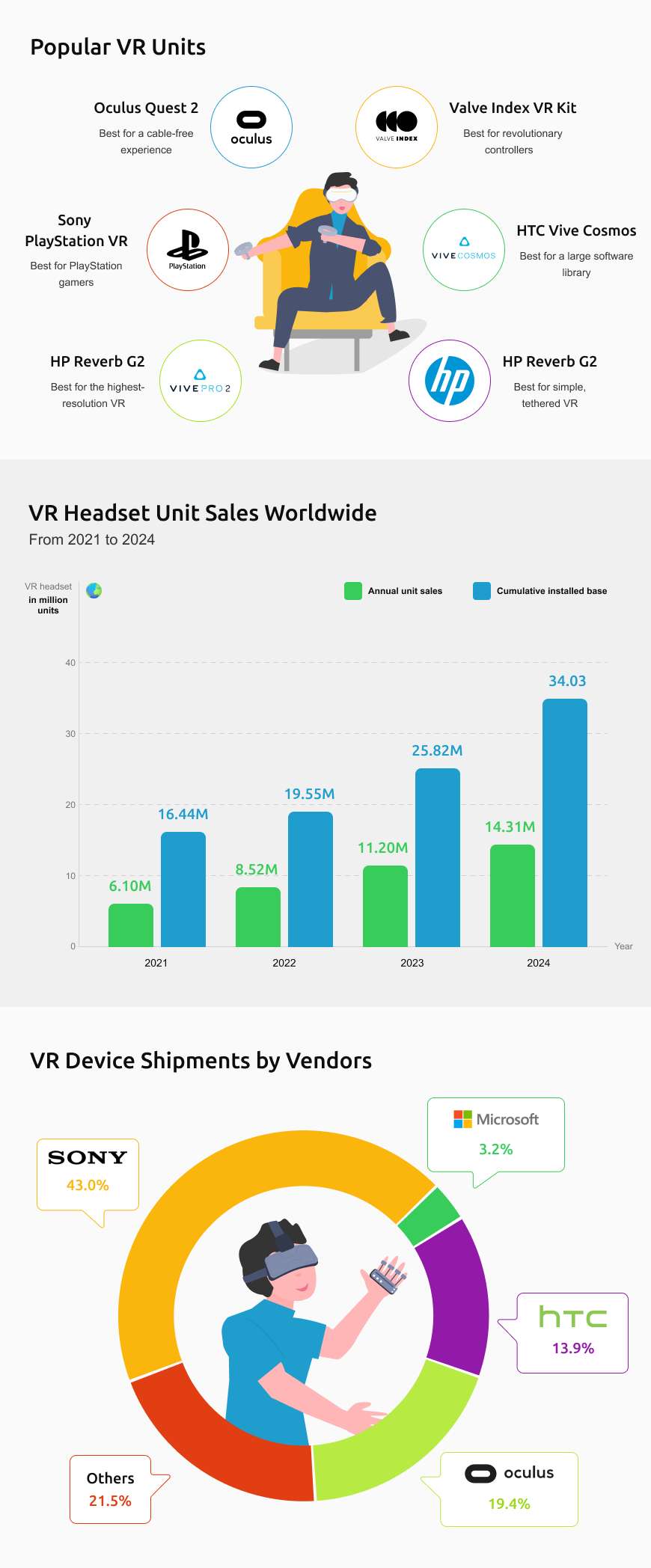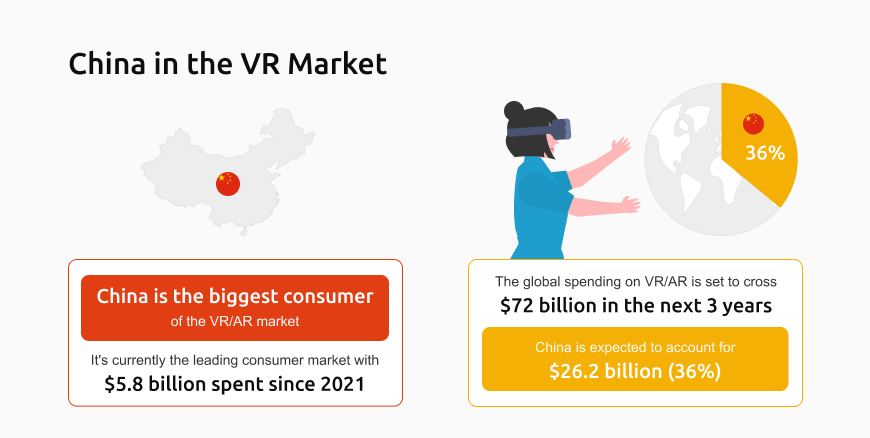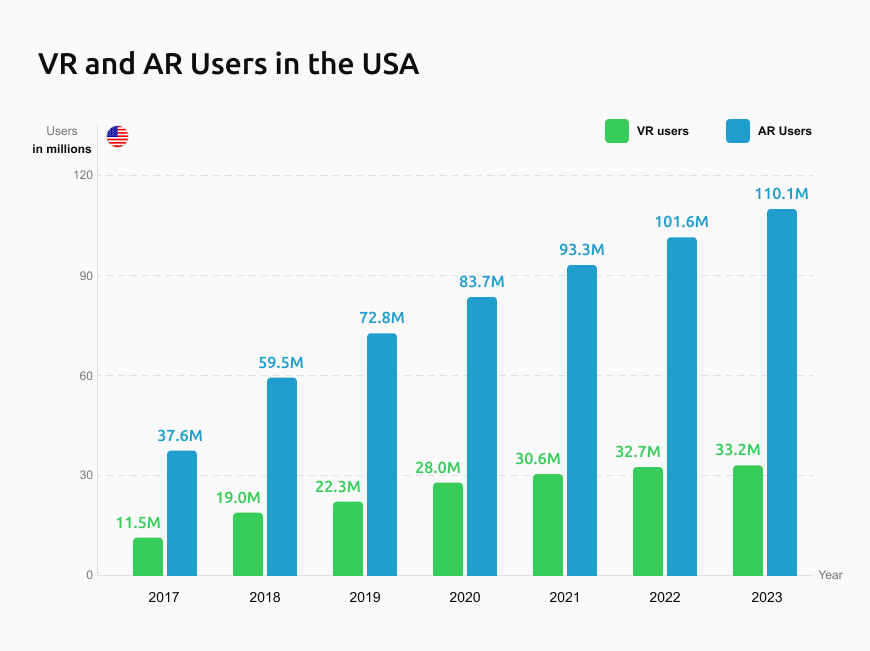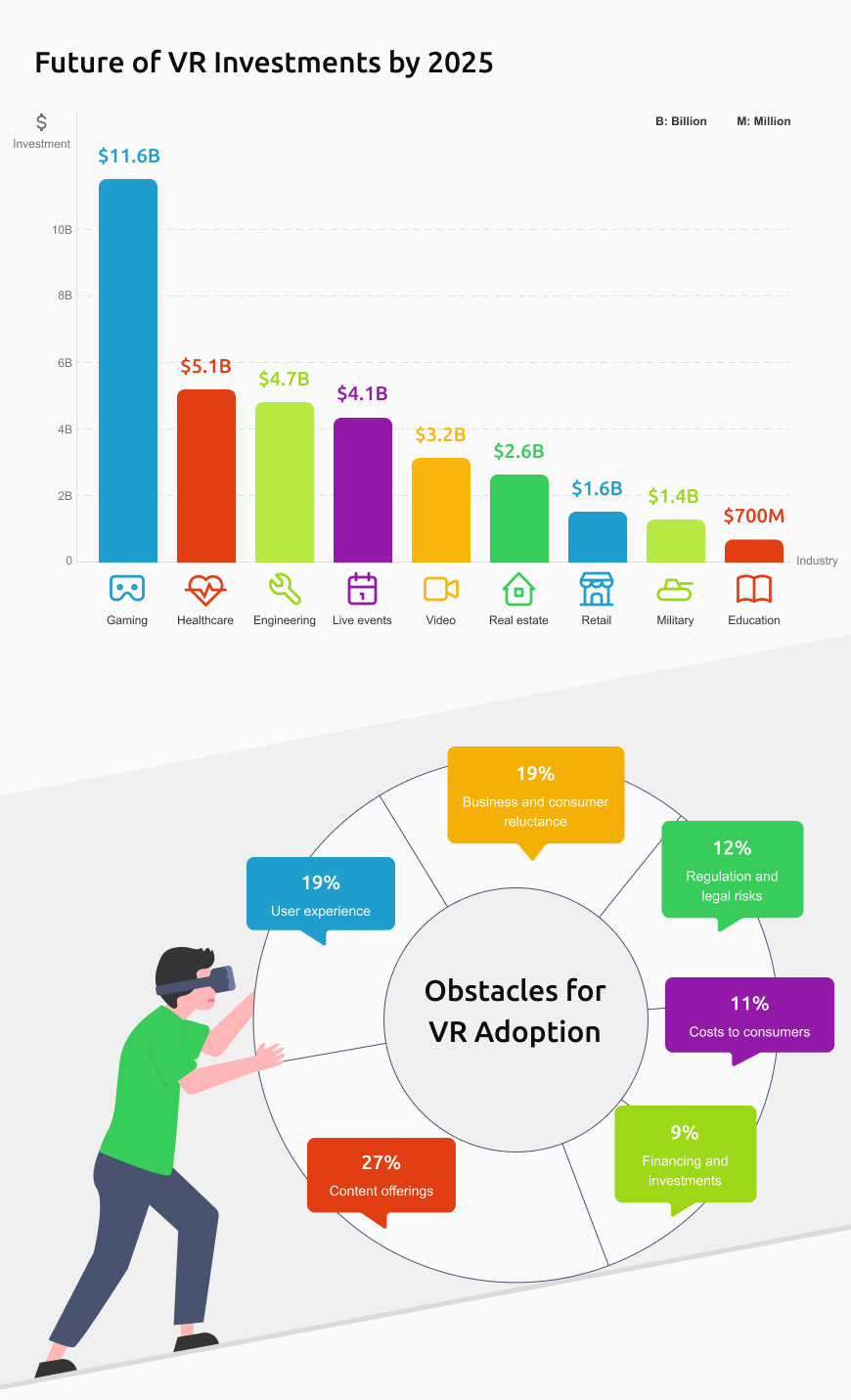Reality has always been dependent on our minds, senses and intuitions.
Now things are changing.

As technology advances, mankind isn’t only living within everyday reality, but is also creating another one of its own: Virtual Reality (VR).
When you have the power of creating reality, there are endless possibilities. It’s a new world of opportunities and applications. Entertainment, Networking, Education, and Communication are some of the avenues where VR is already making inroads. So let’s dive into the world of VR and learn about some of the latest VR statistics!
What is VR?
VR (Virtual Reality) is a realistic environment in 360º created through computer simulations. But what’s different in VR from a normal 3D interface? With the help of hardware such as VR Headsets, the user becomes a part of the VR environment and interacts within the VR through head and body motions.
VR first arose in Sci-Fi fiction literature. But taking it out of the books and into the market with unlimited application prospects is one giant leap that VR techies have taken.
This was made possible with the R&D investments by tech giants like Google, Meta, Sony, Microsoft and others. The huge interest from these companies and their plans regarding VR suggests that we are entering into a new era of technology.
This is reflected by VR device shipments by leading vendors, with Sony, Microsoft, HTC and Meta-owned Oculus leading the way. Between them, Sony and Meta corner over 60% of the device shipment market!

VR Market Size
It took global companies and brands some time to realize the potential of VR. With the ever-growing market applications of VR, its market is now beginning to show some promise.
- The virtual reality market was valued at $4.84 billion in 2021. This means that the virtual reality market grew by 51% compared to the year 2020, and we’ve only seen further growth in 2022 and expect it to touch $6.71 billion. And in 2025, VR market is expected to reach $20.9 billion!
- China is the biggest consumer of the VR/AR market. As global spending on VR/AR is set to cross $72 billion in the next three years, China is currently the leading consumer market with $5.8 billion spent since 2021.

- The MetaVerse market could reach $13 trillion with 5 billion users by 2030. In a time when users are yet to fully understand what Metaverse actually is, a study by Citi Bank predicts that the MetaVerse is the future of technology.
- Individual consumers are the biggest contributors to the virtual reality market. More virtual reality statistics from the IDC report show that the Individual buyers did 53% of the total VR investments, followed by the Retail industry (16%), and Manufacturing (14%).

VR Users
It’s a fact that the VR adoption has been slow from the end-user side. The reasons for this were obvious; even the best in the tech business including the leading tech companies were unsure about the wide-scale applicability of VR/AR.
There were restraints too that hindered the rapid market penetration of VR. A few of them were seamless user experiences due to connectivity problems and a lack of high-resolution VR experiences.
However, with more research and more funds being pumped into the VR sphere, the progress is now visible across the domestic market. The virtual reality statistics below present rather an expected picture of user adoption where consumers from the industrial world are the first to adopt VR products and services.
- There are 171 million VR users right now. The same report also looks into the age segments where VR is more popular and without any surprise, youngsters in the age bracket 16-34 years comprise over 65% of the total VR users.
- In the US, the number of VR users will exceed 95 million in 2022. Another report by Fortune suggests that the global AR/VR market is set to grow worth $227 billion by 2029. It seems just a matter of time until the user base of VR technology grows substantially.

- 40% of all VR technology users watch and play video games. Social media is the winner right now with 47% usage, followed by video games. VR users are also very interested in entertainment, music, and advertising.
- 78% of the internet users in the US know about VR; Almost 80% of users in the biggest economy of the world have read about VR; and about 20% of the users have already tried VR technology.
- 30% of the AR users agree to in-app purchases. Ads are a game-changer for any platform. With the introduction of ads in the VR/AR technology, almost every business will look to invest and target the VR audience.

VR Gaming
The gaming industry was one of the first to utilize VR’s potential. Gaming development companies are already utilizing the available tech to generate billions of dollars in revenue. This will obviously improve with the development of much better VR hardware and software.
5G incorporation will change the game; not only for the virtual reality gaming industry, but all other industries that aim to streamline their processes and make their infrastructure 5G compatible. This will enable them to provide their users with seamless VR experiences. For a clear picture of the current VR gaming market, here are some of the latest VR gaming statistics.
- Pokemon Go, the iconic VR game, has earned more than $4 billion so far. This game alone can take the credit for making VR/AR a global sensation. It not only took the gaming world by storm but also provided a much-needed boost to the virtual reality gaming market.
- VR Gaming generated $1.4 billion in 2021 alone. Annual revenue will go up to $6.9 billion in 2025, according to some figures. The Business Research Company predicts much higher figures of up to $9.39 billion. It expects the gaming industry to grow 40% in 2022 and potentially generate around $12.1 billion.
- Alphabet’s VR Headsets are the most popular Headsets among VR Gamers. 25.9% of all the gamers use Oculus Rifts S. Other popular headsets include HTC’s Vive and Valve Index HMD.

Sectors Driving VR Growth
The idea of simulated experiences excites customers and users from all industries. Gaming, Education, Healthcare, Retail, Security, Manufacturing, and e-Commerce have already adopted VR as an important component of their operations. As a result, these industries of which VR impacts growth are the main investors in the VR sector.
Industry researchers believe that the upcoming implementation of the 5G technology and open MetaVerse are two of the main industries that will drive the exponential growth of VR technology. VR use cases might currently face hindrances due to interruptions in connectivity, resolution problems, and operational speeds, 5G will hopefully solve this problem.
On the other hand, as 5 billion people will be part of MetaVerse by 2030, VR will eventually become the main driving force behind this $13 Trillion market.

Challenges and Predictions in the VR Market
Key Players
The key players in the VR global market today are technology manufacturing companies and other global tech/business giants. These companies are either producing VR products or platforms already, or they are using VR to improve the consumer experience.
Take the example of Alphabet Inc. Not only has it built the VR Headset brand named Oculus for high-resolution VR experiences, but it has also announced other state-of-the-art VR tools. Also, the MetaVerse itself is a VR-centric platform that allows users to build a whole new virtual world.
Other companies including Lenovo, HTC, and Sony are investing heavily in VR research and development. Apple Inc. has also recently acquired a VR events management platform named NestVR.
Overall, all the big names in the tech industry today, while making efforts to stay relevant to the VR world, are also playing their part in VR technology development.
Market Predictions
Given the industrial interest in VR and AR-backed technologies, the future VR market is looking set to grow. Away from gaming, potentially over $5Bn will be invested into healthcare. Other big sectors are also looking likely to invest in VR-based technology, with major players in the education and military spheres both likely to invest around $1Bn into the VR market.
These investments are reflected by potential VR headset investments worldwide. From 2021-2024, there will be a predicted twofold increase in VR headset unit sales, from around 6.1 million units per annum in 2021 to over 14 million units per annum in 2024.
All of this wide-scale cross-industry adoption of the VR tech suggests that VR could easily outperform “reality” on many fronts already. As a result, predictions that VR is going to be the “mainstream reality” of the future do begin to make sense.

Final Thoughts
VR is futuristic and has the potential to disrupt the present global tech market. Moreover, the statistics above suggest that the future is now. The phase where the flame of VR burnt slowly for many years has passed. Backed by the biggest global tech companies, now is the time when VR blooms to its brightest days.
Although the main use cases of VR technology are in the gaming and entertainment industries, it’s about time that other industry lines such as e-Commerce, Consumer and Retail, Education, Medicine, and others, realize the potential of VR in modernizing their operations and maximizing their ROIs.
While most of the global business came to a halt during Covid-19, the VR Industry was one of the few businesses that grew. And now as the world is moving towards remote work and virtual work not by obligation, but by choice, the better days for the VR industry are around the corner.
Full-size infographic:

